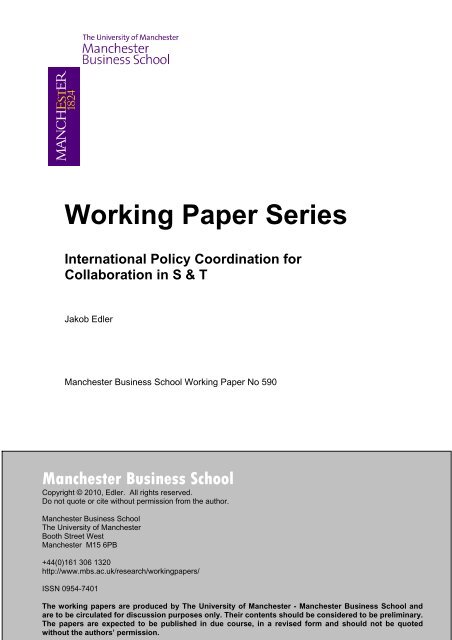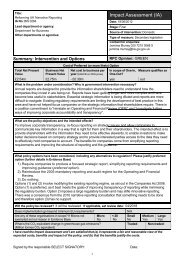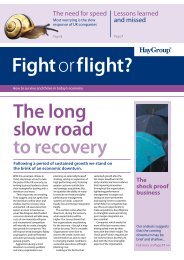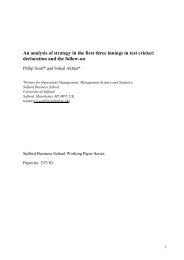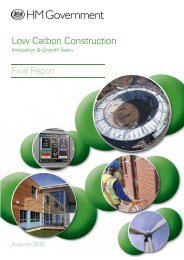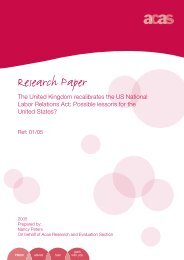Heiko Prange - Management and Business Studies Portal
Heiko Prange - Management and Business Studies Portal
Heiko Prange - Management and Business Studies Portal
Create successful ePaper yourself
Turn your PDF publications into a flip-book with our unique Google optimized e-Paper software.
Working Paper SeriesInternational Policy Coordination forCollaboration in S & TJakob EdlerManchester <strong>Business</strong> School Working Paper No 590Manchester <strong>Business</strong> SchoolCopyright © 2010, Edler. All rights reserved.Do not quote or cite without permission from the author.Manchester <strong>Business</strong> SchoolThe University of ManchesterBooth Street WestManchester M15 6PB+44(0)161 306 1320http://www.mbs.ac.uk/research/workingpapers/ISSN 0954-7401The working papers are produced by The University of Manchester - Manchester <strong>Business</strong> School <strong>and</strong>are to be circulated for discussion purposes only. Their contents should be considered to be preliminary.The papers are expected to be published in due course, in a revised form <strong>and</strong> should not be quotedwithout the authors’ permission.
Author(s) <strong>and</strong> affiliationDr. Jakob EdlerManchester <strong>Business</strong> SchoolBooth Street WestManchester M15 6PB, UKPhone: +44 161 1320E-mail: jakob.edler@mbs.ac.ukAbstractThis paper discusses an increasingly important, yet challenging development,the international coordination of nationally rooted policies or funding schemes tosupport international collaboration in science <strong>and</strong> technology (S&T). Itconceptualizes ways in which government ministries or agencies can realisesynergies when it comes to supporting international activities of theirresearchers. Although the principles developed for international coordinationcan be generalized, it is set in the context of the European Research Area(ERA).Existing conceptual <strong>and</strong> empirical analysis has shown that coordination of policyto foster international S&T collaboration is by <strong>and</strong> large rather poor evendomestically. The paper argues that international coordination of nationalpolicies for international S&T collaboration meets an additional set of challengesthat need to be tackled systematically. The conceptual considerationspresented in this chapter can lay the basis for an analysis of currentcoordination activities. They can, however, also be utilised to design systematiccoordination schemes for policies geared towards international collaboration asthey provide the major elements of strategic approach for such an internationalcoordination approach.How to quote or cite this documentEdler, J (2010).International Policy Coordination for Collaboration in S & T. Manchester<strong>Business</strong> School Working Paper, Number 590 available:http://www.mbs.ac.uk/research/workingpapers/2
International policy coordination for collaboration in S&TJakob Edler1. Introduction: three mega trends in international S&T policiesThis chapter discusses an increasingly important, yet challenging development, theinternational coordination of nationally rooted policies or funding schemes to supportinternational collaboration in science <strong>and</strong> technology (S&T 1 ). It conceptualizes ways inwhich government ministries or agencies can realise synergies when it comes tosupporting international activities of their researchers. Although the principlesdeveloped for international coordination can be generalized, it is set in the context of theEuropean Research Area (ERA). This is important since European instruments haveprovided novel opportunities for coordination, in various forms <strong>and</strong> with varyingsuccess. Some of those coordination activities have targeted or entailed internationalS&T collaboration by combining two international levels: they have allowed nationalministries <strong>and</strong> agencies to coordinate with other partners from Europe (‘international’from the national perspective), in order to better support international S&T activitieswhich have often reached beyond Europe’s borders.The topicality of policy coordination for international S&T collaboration becomesobvious when looking at three related, mutually reinforcing mega-trends. The first megatrend is that international collaboration in science <strong>and</strong> technology became of increasingimportance. All indicators, such as co-publications, co-inventions, <strong>and</strong> joint researchprojects, point in the same direction. This is true not only in absolute terms, but also asregards the relative importance of international collaboration which has grown versussingle authored publications <strong>and</strong> national co-authorship. This development is strongwithin the OECD world <strong>and</strong> the emerging economies, like the BRIC countries (Wagner<strong>and</strong> Leydersdorff 2007; Glänzel 2001). Especially China has noted a dramatic rise ofinternational co-publications, with an increase of more than 100 per cent between theperiod 1995-2000 <strong>and</strong> 2001 to 2005 (Adams et al. 2007).1 For the sake of clarity, the discussion is limited to science <strong>and</strong> technology <strong>and</strong> does not includecoordination of policies to internationalize innovation activities, as rationales, addressees, related policydomains (trade, industry policy etc.) <strong>and</strong> related governance actors are quite different in innovation fromscience <strong>and</strong> technology.3
Figure 1: The rise of international co-authorship, example of natural science300Thous<strong>and</strong> articlesDomestic co-authorship250200150Single-institutionalco-authorshipInternational co-authorship100Single author5001985 1987 1989 1991 1993 1995 1997 1999 2001 2003 2005Source: OECD STI Scoreboard 2007, based on NISTEP.Interestingly, while the share of international, extra-European collaboration is alsorising (see table 1), the collaboration within Europe has increased much more than theco-publication with extra-European partners (Mattison et al. 2008). This, it seems, is animportant fact, given the global dispersion of specialised knowledge production <strong>and</strong> itpoints towards a real need for policy action towards truly international policies – <strong>and</strong> itrenders intra-European coordination of extra-European collaboration the moreimportant.Table 1: Impact of international collaborations in science 1991 vs. 20034
Not only does the share of international co-publications rise, even more importantly, theimpact of international collaborations – one measure for scientific excellence <strong>and</strong>relevance – seems to have grown significantly. Bibliometric data indicates thatinternational activities pay off. The number of citations a published paper receives canbe used to approximate the level of impact that it has among peers (Glänzel et al. 2006)The figures show that international collaborations systematically display above-averageperformances. 2 In addition, while for the EU15, the US, <strong>and</strong> Japan a slight decrease isobserved, all other countries in the table register upwards trends.In addition to the scientometric impact, a recent survey of scientists in Germany foundthat the vast majority of researchers experience a net utility gain from their internationalactivities. Internationalization helps German <strong>and</strong> foreign researchers to make a name forthemselves <strong>and</strong> to step up their performance (publications, co-operations). They see adirect link between internationalisation <strong>and</strong> their own careers in research. Internationalactivities accelerate the generation of knowledge, avoid duplicated work, increasecompetencies <strong>and</strong> increase researchers’ (measurable) output (Edler et al. 2007). 3The trend towards international S&T collaboration has been fostered <strong>and</strong> accelerated bytwo major political trends which, in fact, have positively changed the l<strong>and</strong>scape forsupporting international S&T. One of those trends is global, the other one Euro-centric,but with potential global consequences.Thus, the second mega trend is that political ambitions to support <strong>and</strong> utilizeinternational S&T have deepened <strong>and</strong> broadened. Fostering international S&T is notexclusively linked to science policy goals any more. It is not only about improving theconditions for scientists to create knowledge as such, but about contributing towardssolutions for a whole range of global 'gr<strong>and</strong>' challenges (Aho et al. 2006). Thetraditional drivers of effectiveness (complementary knowledge) <strong>and</strong> efficiency (sharedinfrastructure) of knowledge production have been complemented by attempts tointegrate international collaboration into problem driven, mission oriented research(Boekholt et al 2009). 4The third mega trend constitutes a vast increase <strong>and</strong> broadening of international <strong>and</strong>transnational policy initiative <strong>and</strong> instruments to foster <strong>and</strong> shape international S&Tcollaboration. The policy <strong>and</strong> funding l<strong>and</strong>scape – especially in Europe – has changeddramatically within the last decade <strong>and</strong> recently we have witnessed a major shifttowards flexible, intertwined instrumentation to enable <strong>and</strong> support internationalscientific collaboration. For many decades there have been Intergovernmental ResearchOrganizations (IGROs) such as EMBL, CERN etc. in areas with common infrastructureneeds <strong>and</strong> with costs that are too high for individual countries. Within Europe, theResearch Framework Programme (FP) has provided the opportunities for small scaletrans-border cooperation in application oriented research. This has been accompaniedby smaller <strong>and</strong> less ambitious networking <strong>and</strong> partly co-financing activities, such as thebasic research scheme COST (basic research networks) <strong>and</strong> the industry focusedscheme EUREKA. The ERA dynamics which started in 2000 have catalyzed a move2 Superior performance here implies impact in terms of readership. Whether this implies research ofsuperior quality is a controversial aspect of the academic debate.3 Similar results are reported from a study on UK researchers (Technopolis 2005).4 The intensified attempts to utilise S&T collaboration within domain based or mission oriented policyareas globally appears obvious, yet we have little systematic knowledge about the ways in which existingdomain based organisations such as the International Energy Agency actually contribute to theinternational production, diffusion <strong>and</strong> utilisation of scientific knowledge <strong>and</strong> technologies.5
towards more flexible coordination. Firstly, ERA established a new, direct instrument atthe European level (the European Research Council, ERC), supported structuralintegration through Networks of Excellence (NoEs), <strong>and</strong> worked towards joint largescaleresearch infrastructures (with ESFRI). Secondly, it offered new possibilities forjoined-up actions, namely: ERA-Nets, ERA-Net-Plus <strong>and</strong> 'Art. 169'-initiatives forfunding agencies <strong>and</strong> ministries. In addition, the policy related discourse of industry hasstarted to Europeanise (as signified by the Technology Platform activities at Europeanlevel, see below). Companies have realised that in order to optimise their owninternationalisation strategies, coordinated efforts between the large industrial players aswell as between the national governments are needed.These initiatives have broadened the tool box for national ministries <strong>and</strong> fundingorganizations when it comes to supporting S&T collaboration <strong>and</strong> they have beencatalytical for a development towards flexible internationalization policies. Previously,ministries <strong>and</strong> agencies provided (limited) access to their programmes (generallywithout financial support of foreign actors) or encouraged scientists to be mobile <strong>and</strong>cooperate internationally within their nationally funded projects. Now, ministries – <strong>and</strong>funding agencies – are defining explicit internationalization strategies. In a recentcountry survey by CREST (CREST Working Group 2007), 10 out of 22 countriesreporting on internationalization strategies claimed to have a comprehensive strategy inplace, three of which being part of a general globalization strategy, seven being part oftheir respective S&T-strategies. Apparently, eight countries were in the process ofdefining a strategy. However, it also became clear that while strategic aspirations arehigh, the concrete finalization <strong>and</strong> implementation rather remains a promise thanbecoming a reality in most of the countries (CREST Working Group 2007, pp. 12-14).It is interesting to note that the drivers for internationalization strategies are very similaracross the countries reviewed, <strong>and</strong> there appears to be a canon of drivers widely sharedwithin the European countries (CREST Working Group 2007, II-III). In general, themost important drivers are: (1) strengthening (domestic) excellence through access toexisting excellence <strong>and</strong> facilities abroad <strong>and</strong> through attracting talent into the domesticsystems (inward mobility), (2) preparing the ground for domestic innovations to bemarketed abroad, <strong>and</strong> (3) contributing to the solution of global problems.Consequently, the countries now have started to look systematically for synergies inachieving their internationalization goals within Europe (CREST Working Group 2007;Edler et al. 2008; Boekholt et al. 2009). Those unilateral initiatives are more <strong>and</strong> morelinked to the new forms of coordination as offered at European level. Thus, nationallybased internationalization strategies go h<strong>and</strong> in h<strong>and</strong> with coordinated activities to thinkabout joint action in order to foster international mobility <strong>and</strong> collaboration.It is, of course, far from clear where the combination of those three trends will lead to.One can argue, however, that the interplay of those mega trends marks nothing less thanthe beginning of a paradigm shift in policies to foster international S&T collaborationacross Europe, with flexible combinations of joint activities by different countries,represented by ministries <strong>and</strong> agencies. Such variable coordination logic not only offersthe option of appropriate coordination within Europe <strong>and</strong> for European researchers, butalso helps to define ways <strong>and</strong> means to support international, extra Europeancooperation in science <strong>and</strong> technology more efficiently <strong>and</strong> effectively.This opens up a whole range of analytical <strong>and</strong> conceptual issues, both for policy makers<strong>and</strong> analysts alike. The efficiency <strong>and</strong> effectiveness gains to be reaped fromcoordinating national initiatives can only be realized with a very conscious approach,6
with a clear underst<strong>and</strong>ing of the nature of coordination <strong>and</strong> the institutional challengesassociated with it. This is what this chapter seeks to support.The remainder of this chapter starts off with a discussion of a definition of policycoordination (section 8.2.). It then offers some illustrations of international coordinationefforts, mainly based on ERA-NETs <strong>and</strong> European Technology Platforms, the latterbeing a bottom up, industry driven coordination process with accompanying policycoordination (section 8.3.). Section 8.4. then argues that there are four major conditionsthat have to be met for successful international policy coordination. In principle, all ofthose have to do with coming to grips with the complexity of the issue: (8.4.1.)awareness of the multitude of goals in international S&T collaboration from theperspective of those that shall be coordinated, (8.4.2.) underst<strong>and</strong>ing of the rationales<strong>and</strong> contexts of all the (institutional) actors that engage in coordination, (8.4.3.)systematic underst<strong>and</strong>ing <strong>and</strong> conscious choice of coordination functions <strong>and</strong> modes,<strong>and</strong> finally (8.4.4.) underst<strong>and</strong>ing of the domestic institutional complexity (in itself ahorizontal <strong>and</strong> vertical coordination challenge) as a prerequisite for successfulinternational policy coordination. On this conceptual basis, the chapter ends with astylized decision model for developing coordination activities (section 8.5.), whichshould provide a framework for policy-makers to think about design <strong>and</strong>implementation issues in a systematic way.2. What is coordination in S&T policy – <strong>and</strong> what is it not?The concept of coordination is abundant in political rhetoric, but it is poorly defined <strong>and</strong>we hardly have a common underst<strong>and</strong>ing of what we mean (for many see Peters 1998,2005; Metcalfe 1994).'Even if the general meaning is clear, co-ordination is a surprisingly ill-definedconcept with imprecise implications. Despite its importance in practice <strong>and</strong> thekey role it plays in theories of administration there is no consensus on how itshould be defined <strong>and</strong> operationalised' (Metcalfe 1994, p. 278).To define modes of coordination <strong>and</strong> their best usage, we can start by looking at what itis not, i.e. we can demarcate the notion of coordination from related concepts. First,'coordination' is quite different from 'collaboration'. Collaboration, in its most generalsense 5 can be defined as ‘to work jointly on an activity or project’. In terms of S&T themeaning differs for different levels <strong>and</strong> actors. On the level of concrete scientific <strong>and</strong>technological activities it means that two or more researchers work intentionally 6together to achieve certain scientific goals, to pool their complementary expertise orresources, thus enhancing the effectiveness or efficiency of knowledge production oreven enabling new knowledge to be produced in the first place. There is no need toengage in an in-depth discourse on the intensities <strong>and</strong> intentionality of working together5 We follow the Oxford Dictionary here.6 It can be argued, as Subramanyam (1983) has done, that by using concepts of colleagues <strong>and</strong> working insuccessive steps to accumulate complementary knowledge scientists collaborate all the time, with all theydo. However, for the purpose of this chapter I define collaboration as an intentional activity of distinctactors to work together in order to achieve a certain goal.7
<strong>and</strong> forms of collaboration (for a thorough discussion see Katz <strong>and</strong> Martin 1997), but itis important to keep in mind that S&T collaboration means the working together ofscientists to produce scientific <strong>and</strong> technological knowledge.On the level of S&T policy the concept of collaboration is more complex. The majorelement, again, would be to work together on a concrete, distinct project on the policylevel in order to achieve common goals. This could manifest itself in joint monitoring ofinternational activity, sharing a foreign contact office etc. or – in fact – joining forces insome additional, new joint activity. Policy collaboration would not entail any shift ofcompetencies to a new policy level. Competencies <strong>and</strong> autonomy would remain withineach collaborating policy actor (a ministry or agency).A shift of competencies or autonomy to a new, a common level would indicate'integration' which is again distinct from coordination – even when the boundaries areblurred. Integration describes a process of combining activities or structures so that theythen form a 'new whole' (Nedeva et al. 2006). In institutional terms it means thatindividual elements come into a common participation in a new institution or body. Tounderst<strong>and</strong> what this might mean in terms of policy, we can turn to Europeanintegration theory (see for example Wiener <strong>and</strong> Dietz 2004), which has taught us thatintegration is a process that involves a transfer of competencies <strong>and</strong> loyalty from onelevel to the integrated level, with the various parts of the new whole to arrange for acommon governance structure. This means to delegate authority <strong>and</strong> to assign the newintegrated structure with its own actor capabilities.At the level of concrete R&D activities, integration would be the complete merger ofresearch capacities (e.g. research institutions merge into a new virtual or physicalinstitution, or researchers merge their programme lines altogether). At the level of R&Dpolicies <strong>and</strong> programmes, integration would mean to create a new programme, togetheras a group, <strong>and</strong> to have this programme managed <strong>and</strong> further developed at the new, theintegrated level. 'Art. 169'-activities, should they develop self-st<strong>and</strong>ing, sustainablestructures <strong>and</strong> legally binding rules that are decided upon at the new, integrated level,are one potential form of integration, where the integrated activity (that is the 'Art. 169'-programme) <strong>and</strong> the national activities (these are the national programmes) will co-exist(for a detailed account of one example see Edler et al. 2008).Coordination involves elements of both, integration <strong>and</strong> collaboration, but still isdistinct from both concepts. In a very general definition coordination means to bringdifferent elements (of a complex activity or organization) into a 'harmonious' orefficient relationship. 7 This may involve negotiation (with coordination partners) inorder to match or to harmonize. The major characteristic here is that the variouselements are still autonomous, they do not strive to be merged into one new entity, <strong>and</strong>they still engage in their individual activities. It is not so much joint activities that arethe key here – this would be collaboration if focused on concrete activities, orintegration if aimed at structural merger of some sort. International S&T policycoordination would mean to undertake activities in order to adjust <strong>and</strong> combineindividual activities in a certain area so that they better interact <strong>and</strong> synergize withactivities of other countries in the same area. However, it might involve or lead toconcrete collaboration (in targeted activities) <strong>and</strong> it might develop into partial or fullintegration (for example of programmes, labs etc.). At the same time, however, it canremain in a state of mutual information <strong>and</strong> minor adjustments in national programmes7 Again as defined by the Oxford Dictionary.8
or future design of programmes, or it might simply mean mutual opening up of nationalactivities <strong>and</strong> the like. But it is important to make these distinctions as all too oftenanalysts <strong>and</strong> policy-makers talk about integration when they mean coordination in amore narrow sense – <strong>and</strong> vice versa.Before discussing the conceptual challenges of international S&T policy coordination,the following section provides some recent illustration of various coordination modes.They refer mainly to European research policy <strong>and</strong> entail industry driven modes ofcoordination which, however, receive support from policy-makers <strong>and</strong> in a way forcethem into coordination activities as a consequence of transnational discourse.3. Some illustration of international coordination in the ERA 83.1. ERA-Nets as a means to coordinate international S&T collaborationThe Sixth Research Framework Programme (FP6) introduced the ERA-Net instrument.Its aim is to bring together programme owners <strong>and</strong> managers of a group of countriesthat share a common interest in a specific research area in order to explore possibilitiesof coordinating their efforts, in some cases leading to jointly funded calls (ERA-Net-Plus). The instrument was originally not part of the internationalization agenda of FP6.However, a couple of ERA-Nets developed into instruments to coordinate member stateactivities vis-à-vis third countries or regions. In addition, a range of other ERA-Nets inFP6 had considerable international activities. Some examples are given in the tablebelow.Table 2: International dimension of ERA-NetsSource: Wittke (2008)8 This section builds on Edler (2008).9
In a survey of the European Commission conducted in 2006, 20 per cent of theresponding ERA-Net indicated to have at least one international partner <strong>and</strong> almost 50per cent of the ERA-Nets would welcome a global dimension of their network,especially if there was a sound coordination across Europe as a preparatory step (Wittke2008). The activities of the four ERA-Nets mentioned in the box above indicate thatnew forms of joint action with partner regions are being developed (see the example of'Co-Reach' below), joint action that links to the Framework Programme <strong>and</strong> is flexiblein terms of participation by clustering member states regionally.Box 1 indicates the flexible forms of coordination used by the Norwegian ResearchCouncil (NRC). The NRC employs different kinds of instruments for different areas,thus, the coordination l<strong>and</strong>scape is tailored to the needs of the various areas. The NRChas a three tier arrangement, with bi-lateral activities to foster concrete <strong>and</strong> specificneeds, regionally coordinated approaches to take advantage of similar needs <strong>and</strong>networks of neighbouring countries when it comes to global cooperation partners <strong>and</strong>options, <strong>and</strong> finally, the NRC engages in multi-country schemes using establishedinternational frameworks.10
Box 1: The coordination matrix of the Norwegian Research CouncilCO-Reach – an ERA-Net in FP 6 as means to coordinate for international collaborationCO-Reach brings together 16 European partners <strong>and</strong> almost the same number of Chinesecounterparts (ministries <strong>and</strong> funding organisations <strong>and</strong> Academy of Science etc.), with thefollowing mission:‘This network is intended to create coherence <strong>and</strong> synergy in Europe's S&T relations withChina. It will do so by promoting the co-ordination of China related policies <strong>and</strong> associatedresearch funding programmes of individual European countries, <strong>and</strong> integrating these effortswith those of other multi-lateral European initiatives, including the programmes <strong>and</strong>agreements of the European Commission.”The first pilot activities, two joint programmes in social science <strong>and</strong> sustainability, have beenlaunched in 2008 <strong>and</strong> the network has come to provide a dynamic information system onscientific <strong>and</strong> funding activities, a whole range of high level joint events <strong>and</strong> a platform formultilateral <strong>and</strong> bilateral Chinese schemes (www.co-reach.org). The coordination gain is notonly through new funding programmes, but through reducing complexity, through poolingexpertise <strong>and</strong> networks CO-Reach established the ground for further multi-lateral <strong>and</strong> bi-lateralactivity. While there is still a way to go for a clearer identity of the network, it has alreadychanged the way the science <strong>and</strong> funding discourse between Europe <strong>and</strong> China is led, withoutdistorting the flexibility of single country approaches or of smaller country groupings to developtheir own strategies.The following matrix shows how the Norwegian Research Council organises their strategytowards international collaboration with China, taking advantage of the coordination instrumentCO-Reach, but also using bi-lateral <strong>and</strong> multi-lateral coordination schemes as appropriate forcertain issue areas <strong>and</strong> policy goals (Kveseth 2008).11
3.2. Coordinating international collaboration with <strong>and</strong> for industry: the role of EuropeanTechnology PlatformsEuropean Technology Platforms (ETPs) offer new options for joint coordinationapproaches between the industry <strong>and</strong> policy makers. ETPs are targeted at <strong>and</strong> used byfirms, but coordination takes place in a joint approach with national policy makers <strong>and</strong>the European Commission. ETPs support a systematic discourse <strong>and</strong> the development offuture strategic research agendas (SRA) for certain technologies or sectors. Between2002 <strong>and</strong> 2006 31 ETPs have been established. In FP7 five ETPs have been transferredinto Joint Technology Initiatives (JTIs) that now constitute a new forum for publicprivate partnerships between the Commission, the member states <strong>and</strong> industry with aview to industry-led coordination of research activities in a certain technology. Industryledcoordination from bottom-up is accompanied by country mirror groups challengingthe responsible national policy makers that have a strong representation within the ETPsto engage in some sort of accompanying policy coordination. Some evidence suggeststhat coordination at European level is a catalyst for domestic coordination or at leastfosters the discourse between stakeholders.ETPs have an in-built international dimension. First, many of the leading companies aremulti-national firms active on a global scale. Through bundling those companiestogether into the ETPs, the definition of a European strategic research agenda hasautomatically been linked to the global dynamics. Second, through developingsystematic activities to define future research directions <strong>and</strong> technology options, ETPshave taken into account the global developments especially when it comes to thedefinition of future potential global lead markets. Third, some of the JTIs (for example,Artemis 9 , ENIAC 10 ) have their roots in EUREKA clusters that had partners fromcountries outside the EU (see also European Commission 2008, p. 46).Fourth, ETPs have started to develop international activities <strong>and</strong> integrate extra-EUpartners. The latest EU status quo report on ETPs (European Commission 2007) obligesETPs to report on their international activities. On this basis, one can get someindication as to the strategic aspiration as for international collaboration. A systematicscan of those short reports shows that 21 out of the 31 ETPs have concrete internationalactivities on an operational level or even strategic aspirations. For 10 ETP theinternational activities are either not mentioned at all or only mentioned in a superficialway, seeing the international dimension in terms of market opportunities to be secured.Most of the 21 ETPs that have a more pro-active approach to international cooperationsee themselves as a European focal point <strong>and</strong> hub for international discourse <strong>and</strong>partnering in the future with strategic ambitions, others have strategically incorporatedinternational organizations in their membership in order to link up with <strong>and</strong> influenceglobal strategies (<strong>and</strong> regulations). Some have already entered a whole range ofcollaboration projects, many of which are explicitly linked to international cooperationprojects of FP6. Two examples of strategic approaches for international collaboration inETPs are given in box 2.9 http://www.artemis.eu.10 http://www.eniac.eu.12
Box 2: The international dimension of FP6 ETPs – two examplesARTEMIS – the international dimension of an ETP in FP6 (prior to its launch into a JTI)The objective of the ARTEMIS international co-operation strategy is to define “modalities” forinteraction between the European R&D community, <strong>and</strong> the main international players in thearea, including research institutions, professional organisations (ACM, IEEE), st<strong>and</strong>ardisationbodies (e.g.: OMG, IEEE), large consortia, funding agencies (e.g.: IST, NSF, DARPA).International Collaboration covers a potentially wide range of activities, from the organisationof technical meetings, high-level meetings, conferences, schools, <strong>and</strong> joint internationalprojects. These may have various aims, including education <strong>and</strong> training, dissemination,definition of st<strong>and</strong>ards, <strong>and</strong> development of joint R&D activities. It is clear that InternationalCollaboration should fit into a global win-win strategy, for achieving the participants’ longrangeaims. Dedicated actions are carried out with regard to co-operation with Nanoelectronicsplatforms in the USA <strong>and</strong> the Far-East (see, e.g. www.inc-conf.net) ENIAC is actively involvedin the INC Conferences, which target international collaboration / co-operation in the field ofNanoelectronics <strong>and</strong> Nanotechnology.Hydrogen <strong>and</strong> Fuel Cell Platform – the international dimension of an ETP in FP6The International Partnership for the Hydrogen Economy <strong>and</strong> the IEA implementing agreementsfor hydrogen <strong>and</strong> fuel cells are the main fora for research co-operation beyond the EU. Theformer is established by ministerial charter signed by 17 members, including several EUmembers. It aims to further international co-operation on hydrogen <strong>and</strong> fuel cell technologies<strong>and</strong> support activities of common interest, such as safety, codes <strong>and</strong> st<strong>and</strong>ards, <strong>and</strong> analysis insupport of policy-making. The work of the HFP platform has provided a European focus forthese international co-operation activities <strong>and</strong> the European partners' contributions to thedefinition of common research priorities in the IPHE has drawn heavily on the work of theSRA, Deployment Strategy <strong>and</strong> the Implementation Plan. International co-operation is veryimportant in specific areas, notably where there are challenging technical barriers, or issues ofcommon interest (e.g. sustainability, safety, st<strong>and</strong>ards).These activities of ETPs may indicate a tidal change, <strong>and</strong> their international ambitionwill further feed back to policy making. European industry not only develops commonforesight <strong>and</strong> planning activities, but speaks with one voice (at least in technologyorientedglobal discourses), has a hub <strong>and</strong> focal point in various key technologies,thinks about strategic global partnering <strong>and</strong> links this partnering with considerations13
• Collaboration as element of mobility strategies in science, providing the basis forthe development of scientific capabilities <strong>and</strong> experience more broadly (in thereceiving environment <strong>and</strong> for the mobile researcher herself);• Additional research markets (contract research organizations, firms as R&D serviceproviders);• Preparing the ground for innovative activities <strong>and</strong> markets abroad, linking tocomplementary skills <strong>and</strong> resources (global value chain integration, firms mainly) oradjusting to local requirements (firms)• Benefiting from cost advantages elsewhere (firms, mainly st<strong>and</strong>ardised activities ofR&D, but increasingly also in specific scientific areas in which low cost countriesare highly competitive – e.g. nanotechnology in China, software development inIndia etc.)• Re-transfer of knowledge to be used at the home location, spill in of internationalknowledge into national innovation systemsBeyond those science-, technology-, <strong>and</strong> market-driven motivations there are political<strong>and</strong> societal drivers who are more <strong>and</strong> more coming to the fore. Internationalcollaboration addresses trans-border or global problems, <strong>and</strong> recent empirical work hasshown that those broad motivations are becoming increasingly important (Boekholt etal. 2009). This, of course, has implications for the national <strong>and</strong> international actorarenas, as a whole set of ministries have started to formulate the need for <strong>and</strong> goals ofinternational S&T collaboration (see below).This richness <strong>and</strong> breadth of motivations thus leads to complexity when it comes tocost-benefit calculations of governments for certain collaborative activities. Theweighing of motivations <strong>and</strong> the context conditions against which the internalcoordination takes place varies considerably. Countries differ in the composition ofscientific <strong>and</strong> economic actors <strong>and</strong> in the relative strengths <strong>and</strong> weaknesses of theinnovation system. What might seem an obvious driving force for one country when itcomes to engage in coordination might be marginal for another. The challenges <strong>and</strong>opportunities of S&T collaboration <strong>and</strong> accordingly the most appropriate mode ofcoordination normally differ between countries. Often these differences are not fullytransparent <strong>and</strong> actors are not sufficiently aware of them. International policycoordination in order to follow those drivers of international collaboration activitiesmust start with a clear definition of the objects <strong>and</strong> motivations for coordination. Therecent survey by the CREST working group on 'Internationalization of R&D' (CRESTWorking Group 2007) has clearly shown how different aspirations <strong>and</strong> modes ofinternationalization policies of countries are.Finally, one aspect most often overlooked when it comes to institutionalizedcoordination is the peculiarity of each issue area – <strong>and</strong> those peculiarities have severeconsequences for the need for <strong>and</strong> benefit from (international) collaboration. It makes adifference to collaborate internationally in the fields of chemistry (scientific field),ageing (social issue) or 'China' (location). As current work in the EU network ofexcellence PRIME 12 shows, different scientific fields – or search regimes (Bonaccorsi2008) – have different needs for international collaboration <strong>and</strong> hence also differentneeds for a coordination of those policies that enable international cooperation. It is12 www.prime-noe.org.15
evident that the scientific area <strong>and</strong> thus the nature of knowledge creation plays asignificant role, with different scientific fields having different needs to shareinfrastructure, pooling data <strong>and</strong> methodological skills (Adams et al. 2007; Wagner2006; Kuhlmann et al. 2008; European Commission 2008). 13It becomes even more complex if international collaboration is organized around certainissues (obesity, ageing, water etc.), as there are a range of different scientific disciplinesto be coordinated. Those, in turn, may have developed very different levels ofinternational collaboration already, <strong>and</strong> very different agencies with different traditionsof international engagement might be involved. All this has to be taken into accountwhen coordinating the overall set of those disciplines. As the PRIME project has shown(Kuhlmann et al. 2008) 14 , the scientific discipline chemistry would not require a thick,very broad international collaboration <strong>and</strong> coordination approach, whereas the fastgrowing, dynamic area of catalysis within chemistry has a high need for internationalcoordination to enable collaboration <strong>and</strong> even integration.4.2. Clarity about the objectives of <strong>and</strong> the responsibilities for coordinationAn obvious – but operationally complex – prerequisite for international coordination isa clear underst<strong>and</strong>ing of 'what' in fact is to be coordinated <strong>and</strong> 'who' is responsible forthis object of coordination. First – <strong>and</strong> as just seen in the previous section – theinstitutional actors that engage in international coordination are very heterogeneous.Coordination requires a thorough underst<strong>and</strong>ing of the capabilities, needs, frameworkconditions, embedded rationales <strong>and</strong> reference frameworks of each of the participants ofthe coordination activities. The institutional settings for S&T policies are very different(along a whole range of categories such as 'agencification', mix of programmes vs.institutional funding, importance of collaborative approaches <strong>and</strong> so on), <strong>and</strong> thus therequirements for the different modes of coordination. For example, if coordination isabout programmes, one needs to underst<strong>and</strong> not only the concrete design or the explicitgoals of the programmes, but the underlying rationales <strong>and</strong> knowledge about who theowners <strong>and</strong> managers of the programme are. The governance of the variousprogrammes or initiatives that should be coordinated <strong>and</strong> the roles of the various actorswithin this governance need to be clarified. The coordination of different traditions <strong>and</strong>structures regarding governance modes poses additional challenges for 'learning' as themajor prerequisite of successful coordination.Moreover, the positioning of the programmes in the institutional <strong>and</strong> systemic contexts'at home' need to be made explicit. This also involves the relative importance <strong>and</strong>leverage of the programmes as regards the programme addressees in the variouscountries, who not only differ in terms of scientific <strong>and</strong> economic ambitions, but also interms of their need <strong>and</strong> inclination to engage in international collaboration. This, ofcourse, leads to very different cost-benefit considerations for the various national actorswho engage in the policy coordination in the first place.13 Although, as Wagner (2006) rightly states, we still do not know enough to link the properties of ascience field to international collaboration patterns, the evidence is not yet consistent <strong>and</strong> a range of nonareaspecific variables interfere.14 See for an illustration www.prime-noe.org/Local/prime/dir/General%20Presentation/News/Bonn_Case_Chemistry.pdf.16
4.3. Underst<strong>and</strong>ing the coordination challenge within member statesInternational S&T policy coordination first of all calls for internal, domesticcoordination. As studies have shown, the need to 'speak with one voice' <strong>and</strong> to engagein European activities often triggers challenges of domestic coordination. Nationalcoordination <strong>and</strong> European/international coordination are interdependent <strong>and</strong> coevolutionary,but without a clear dominance of one over the other. Derlien (1991),Metcalfe (1994) <strong>and</strong> Peters (1998) have extensively discussed the need for internalcoordination <strong>and</strong> the various forms this can take in order to arrive at a strategic actorcapacity <strong>and</strong> an internal clarity that is needed for international policy coordination.For international S&T coordination this is especially interesting. The option tocoordinate internationally can open up new ways to coordinate hitherto unconnected oruncoordinated national attempts as international coordination means that those involvedhave to be transparent <strong>and</strong> explicit with their activities <strong>and</strong> goals <strong>and</strong> thus create themomentum <strong>and</strong> pre-conditions for internal synergies.However, given the heterogeneity of actors in national administrations that deal withR&D funding, there is no single voice when it comes to coordinating national policies.This often leads to strong groups lobbying for specific coordination, instead ofsystematic strategic development. Further, there is very little internal intelligence oninternationalization needs across the various stakeholders <strong>and</strong> fields, which again makescoordination of related policies highly problematic. The internal challenges when itcomes to defining priorities <strong>and</strong> ways of action – as a prerequisite for soundcoordination with other countries – are exceptionally complex for internationalactivities. This has become apparent in a recent exercise for the Irish government 15 , inwhich for the first time in Irel<strong>and</strong> systematic attempts have been undertaken to set up aprocess across the government to define priorities for international activities. This alsoincludes the set up of a discursive process in order to obtain more transparency aboutongoing international activities, future aspirations <strong>and</strong> the relative contribution ofinternational activities to the overall research goals. This kind of cross governmentcoordination mechanisms would in fact be an absolute necessity when it comes todecide in which areas <strong>and</strong> with which partners to coordinate international activities.When looking at the various coordination mechanisms at EU level, we find aninteresting process of defining strategies in an ex-post manner, which emerges from alack of internal coordination. The extensive growth of bottom up coordination throughERA-Nets <strong>and</strong> ETPs has been driven by individual agencies <strong>and</strong> departments ratherthan by an all-government approach within individual countries. Only after a few yearsof uncontrolled – or un-coordinated – growth of such coordination activities EUcountries start to bring those coordination activities under some strategic umbrella. Theseparation of responsibilities for European <strong>and</strong> international policies in many countrieshinders coordinating international polices with European ones, or at least it posesadditional challenges of internal coordination within a country.4.4. Definition of functions <strong>and</strong> modes of coordination15 Conducted by a consortium of Manchester Institute of Innovation Research <strong>and</strong> Matrix, Dublin/Belfast2007/2008 on behalf of FORFAS (Edler et al. 2008).17
Clearly, in order to best translate coordination <strong>and</strong> collaboration motives into concretecoordination action, policy-makers need to consider the different modes of coordination.To underst<strong>and</strong> modes of coordination, we can turn to political science literature, even ifpolitical science has focused mainly on intra-governmental, inter-departmentalcoordination (Peters 2005; Painters 1981). Recently, this has been elaborated fordomestic knowledge policies by Braun (2008) <strong>and</strong> applied to country cases by Edler <strong>and</strong>Kuhlmann (2008), Griessen <strong>and</strong> Braun (2008) <strong>and</strong> Pelkonen et al. (2008). Earlier,Metcalfe (1994) had elaborated on coordination for international governance. However,he has done so in terms of intra-government coordination in order to engage in EUpolicies rather than inter-government coordination itself. Lately, a European expertgroup on the Lisbon Strategy (European Commission 2009) has discussed the variousmodes <strong>and</strong> benefits of coordination of S&T policies within Europe – albeit notespecially related to international S&T collaboration.For coordination within countries, Painter (1981) distinguishes five objectives:(1) reduction of duplication,(2) reduction of policy inconsistency (across government),(3) reduction of bureaucratic <strong>and</strong> political conflictas well as(4) increase of coherence <strong>and</strong> priorities <strong>and</strong>(5) design of a comprehensive all-government approach (reduction of policyfragmentation).These five objectives may fit the need for cross-government coordination to enterinternational coordination. However, it is important to underst<strong>and</strong> they largely do notapply for the inter-national (inter-ministerial or inter-agency) coordination itself. Thereis little need for an 'all-government approach' (5), for an increased coherence <strong>and</strong>priority ordering among different national governments (4), <strong>and</strong> even for a reduction ofinconsistencies (2) as the interests <strong>and</strong> needs of the governments involved might remainquite diverse <strong>and</strong> coordination functions therefore much more limited <strong>and</strong> multi-faceted.Those ambitions would only come in the focus of coordination if it is intended to leadinto integration into a new, coherent whole. This, in turn, would only apply if the EU orsome sub-group of countries would claim to act on behalf of all member states or themembers of that particular group when it comes to all aspects of international S&Tcollaboration. This, however, is far beyond the current policy reality. Even theambitious 'Art. 169'-initiatives largely integrate parts of national policy programmesinto a new programme, but they do not create an entire new whole with distinct strategicactor qualities.Only within the integrated parts would coherence in terms of goals <strong>and</strong> instruments beexpected. Given the diverse interests <strong>and</strong> context condition within the EU, it may beeven detrimental for the very purpose of the coordination – as it would force memberstates into a uniform, single approach when it comes to international S&T collaboration.Equally, the fourth objective, the reduction of conflict between administrations has anentirely different meaning when it comes to international coordination of S&T.Conflicts between administrations of different countries when it comes to internationalS&T collaboration are rather unlikely. However, if it occurs it might be an expression ofcompetition for access to resources, talent, expertise or complementary funds in othercountries. This can be overcome through strategies to create win-win situations when18
joining forces to gain better access <strong>and</strong> offer better exchange with international partnersaltogether.Finally, the fifth goal, avoiding duplication (e.g. in setting up collaboration structures, inperforming research in similar areas etc.) may be a reasonable policy goal ininternational S&T policy coordination. Duplication may in fact often increase variety,<strong>and</strong> is thus a means for improved performance through competition <strong>and</strong> enhancedselection scenario for the best approaches. At least, duplication can offer alternativeroutes to knowledge production with different potential outcomes.Thus, to systematically reduce duplication of international collaboration efforts may becounterproductive. However, competition of approaches is only meaningful if the S&Tcommunity can actually choose <strong>and</strong> if the national approaches for S&T collaborationare open for participation from other countries. If they are not, duplication does notmean competition but inefficiency. In addition, to reduce duplication certainly is anissue for international policy coordination when it comes to build up common structures<strong>and</strong> networks or even harmonized programmes to fund joint work in commonly agreedresearch areas.In short, it is the efficiency <strong>and</strong> effectiveness argument rather than the coherenceargument that is relevant for international S&T policy coordination. Actors coordinateto achieve their own goals better <strong>and</strong> more efficiently. Currently they do not do it toclaim a coherent approach across all EU countries (or a substantive sub-set of countries)or all scientific domains. Coherence would be a goal of policy integration.A second, related issue is the mode <strong>and</strong> thickness of coordination. The thickness ofcoordination has been systematized along various scales. While those scales have beendesigned for intra-government coordination, they can help us to underst<strong>and</strong> the nature ofinter-organizational coordination in policy-making <strong>and</strong> hence also guide the analysis ofinternational policy coordination.Extending the well established dichotomy of the German political scientist Fritz Scharpfwho distinguishes between positive <strong>and</strong> negative coordination, Peters (2006, taken upalso by Braun 2008) develops a five level scale of coordination. He distinguishesbetween1) no coordination;2) negative coordination (mutual information of units who are not independent fromeach other, but no common policy formulation, coordination as adaptation tominimise costs out of actions of others);3) positive coordination (involves pro-active cooperation in order to achieve certaingoals better);4) alignment of goals, which means that not the process or the instrument areharmonized, but the aim that is to be achieved. This mode is most promising if thesystemic features of countries <strong>and</strong> their specific contexts are too different for jointaction or adaptation of frameworks;5) common development of visions, goals <strong>and</strong> strategies.The broader rationale for <strong>and</strong> the thickness of coordination is often entirely unclear, illdefinedor even – more or less – contested. To take but one example, a European ExpertGroup on the Lisbon Strategy has analyzed the Open Method of Coordination (OMC),which can be defined as a set of fora for inter-organizational discourse across Europe,whereby various topics around S&T governance have been discussed with differentcountry groupings involved in each of the groups (European Commission 2009). This is19
important in the context of this chapter as the OMC is international (intra-European). Itbrings together actors from European countries with a mission to establish or preparecoordination. To analyze the nature <strong>and</strong> effects of the coordination, the Expert Grouphas used the approach of Braun <strong>and</strong> Peters <strong>and</strong> concluded that the trans-border, interorganizationalcoordination within the OMC does not show many signs of realcoordination along those scale categories. Most of the international inter-organizationalcoordination groups of the OMC focused on learning from each other (undoubtedly onemajor objective of the OMC) <strong>and</strong> only some of the participants in a limited number ofthose coordination groups aspired to positive coordination or even alignments of goals<strong>and</strong> common visions <strong>and</strong> strategies. None of the 18 groups of the four cycles of theOMC has reported positive coordination or even thicker forms of coordination.However, it appears that the OMC has – through the intensive learning that has takenplace in some of the groups – paved the way for further common activities whichbecome institutionalized – as the new Strategic Forum for International S&TCooperation – <strong>and</strong> as such might lead to further joint activities beyond learning.There has, however, been an interesting diversity of views of OMC participants as towhat coordination actually is, <strong>and</strong> a vast majority appears to have interpreted mutuallearning as the actual objective of coordination <strong>and</strong> thus favoured a mode of knowledgeexchange <strong>and</strong> common reviews over an approach of defining common ground forstrategies. Learning might – as the expert group has recommended – be designed tospeed up the process of adapting to the shared goals <strong>and</strong> to check for possibilities forjoint action. However, in itself it is not coordination in one of the four ways describedabove, not even negative coordination.For the ERA-Net examples above, the picture appears to be very different. Here, itseems there are first signs of positive coordination, as many of those ERA-Nets strivefor synergies in their own national approaches through joint action. But it also appearsthat alignment of goals or even the development of joint strategic visions <strong>and</strong>programmes is still the exception.5. Conclusions – elements of a logic model of coordinationAny policy coordination is complex. Conceptual <strong>and</strong> empirical analysis has shown thatcoordination of policy to foster international S&T collaboration is by <strong>and</strong> large ratherpoor even domestically. This chapter has argued that international coordination ofnational policies for international S&T collaboration meets an additional set ofchallenges that need to be tackled systematically. The conceptual considerationspresented in this chapter can lay the basis for an analysis of current coordinationactivities. They can, however, also be utilised to design systematic coordinationschemes for policies geared towards international collaboration as they provide themajor elements of strategic approach for such an international coordination approach asthey would have to be applied in their logical sequence 16 .The starting point of a strategic coordination process is the definition of goals forinternational S&T collaboration <strong>and</strong> an analysis of the status quo of this collaboration.Already this definition of goals necessitates transparency <strong>and</strong> a co-ordinationdomestically in order to underst<strong>and</strong> how different ministries <strong>and</strong> agencies perceiveopportunities through international collaboration <strong>and</strong> policy coordination. In a second16 This part is inspired by an internationalization concept developed in Edler, J. et al. (2008). It serves as afirst illustration of a potential process development.20
step, the opportunities of international S&T collaboration have to be explicitly defined,based on the overall national S&T priorities – across the various ministries involved –<strong>and</strong> based on the motivations <strong>and</strong> aspirations of the S&T community to collaborate.This opportunity definition needs to take account the heterogeneity <strong>and</strong> specific needsof the research fields. On that basis concrete potential target countries <strong>and</strong> focus areasfor S&T collaboration can be identified. All this definition process may utilise broadstrategic intelligence, such as bibliometric <strong>and</strong> technometric analyses for the profiling ofcountries <strong>and</strong> identification of strongholds. But most importantly it must involve astrategic discourse among policy-makers, research managers <strong>and</strong> scientists domestically.In such an ideal-type process, the international co-ordination is not at the beginning, buta consequence of systematic search <strong>and</strong> definition processes. Obviously, very oftencoordination activities develop very differently, they emerge from discussion fora, frominitiatives of foreign partners, out of policy instruments such as ERA-Net which startwith coordination at European level <strong>and</strong> only subsequently ask for the linkages todomestic contexts <strong>and</strong> arena. However, the ideal-type process stylised here serves tohighlight the importance of internal, national administrative co-ordination <strong>and</strong> discoursewith the scientific community if co-ordination.Once – ideally – purpose <strong>and</strong> targets for international S&T collaboration are identified,the international coordination arena needs to be understood, the activities, rationales<strong>and</strong> interests of other policy actors which seek to support international S&Tcollaboration in one way or the other <strong>and</strong> which have similar policy needs. Thisinvolves mapping global policy <strong>and</strong> funding activities, capabilities <strong>and</strong> opportunities,<strong>and</strong> to link them with existing international policy instruments <strong>and</strong> activities <strong>and</strong>involvement in international organisations. A search <strong>and</strong> definition process atinternational level then would have to define (1) the concrete purpose of thecoordination, situated between pure policy learning on the one h<strong>and</strong> <strong>and</strong> efforts tointegrate programmes (or parts of programmes) on the other h<strong>and</strong> as well as (2) themode <strong>and</strong> thickness of the coordination . The target must fit the mode <strong>and</strong> the thicknessof coordination. The definition must be explicit <strong>and</strong> formulate the added value, thebenefits <strong>and</strong> the pitfalls of coordination – <strong>and</strong>, most importantly, be shared by theinternational partners. Based on the preceding domestic discourse, backing of keystakeholders <strong>and</strong> involvement in subsequent policy action on international level is to beensured.Once action is agreed, structures <strong>and</strong> processes set up, the developments need to bemonitored <strong>and</strong> the added value of international collaboration <strong>and</strong> the change ofopportunities <strong>and</strong> behaviours of the S&T community need to be measured. Thisincludes a constant assessment not only of the benefit (efficiency, effectiveness), butalso of the opportunity costs, i.e. the costs of non-coordination, as well as a clearunderst<strong>and</strong>ing of an exit strategies. Explicit cost-benefit considerations <strong>and</strong> potentialexit strategies are not hampering increased <strong>and</strong> improved co-ordination. To the contrary,they help to avoid international co-ordination to be regarded as a good thing per se,which then is easily ill-defined <strong>and</strong> develops path-dependencies that may lead tomeaningless discourse fora detached form national policy goals <strong>and</strong> needs of thescientific community <strong>and</strong> unable to adopt modes <strong>and</strong> targets of co-ordination to thetransformation of international scientific collaborations.21
ReferencesAD Little (2005), Internationalisation of R&D in the UK - A review of evidence,Cambridge: AD Little.Adams, John, Karen Gurney <strong>and</strong> Stuart Marshall (2007), Patterns of internationalcollaboration for the UK <strong>and</strong> leading partners (available at:http://image.guardian.co.uk/sysfiles/Education/documents/2007/07/13/OSICollaborationSummaryRepo.pdf).Aho, Esko, Jozef Cornu, Luke Georghiou <strong>and</strong> Antoni Subira (2006). Creating anInnovative Europe, Report of the Independent Expert Group on R&D <strong>and</strong> Innovationappointed following the Hampton Court Summit, Brussels.Boekholt Patries, Paul Cunningham, Jakob Edler <strong>and</strong> Kieron Flanagan (2009), Driversof international collaboration in research, Study for the European Commission, DGResearch, Amsterdam, Brussels, Manchester: European Commission.Bonaccorsi, Andrea (2008), 'Search Regimes <strong>and</strong> the Industrial Dynamics of Science',Minerva, 3 (46), 285-315.Braun, Dietmar (ed) (2008), 'The Governance of Knowledge Policy', Special Issue ofScience <strong>and</strong> Public Policy, 35 (3).Braun, Dietmar (2008), 'Organising the political coordination of knowledge <strong>and</strong>innovation policies', Science <strong>and</strong> Public Policy, 35 (3), 227-239.CREST Working Group (2007), Internationalisation of R&D – Facing the Challenge ofGlobalisation: Approaches to a Proactive International Policy in S&T, ANALYTICALREPORT. Policy Approaches towards S&T Co-operation with Third Countries,Brussels.Derlien, H<strong>and</strong>-Ulrich (1991), 'Horizontal <strong>and</strong> Vertical Coordination of German EC-Policy', Hallinnon Tutkimus, 3-10.Edler, Jakob, Patries Boekholt, Oliver Donard <strong>and</strong> Terry Wilkinson (2008), Review ofthe ERA-NET 'iMERA' <strong>and</strong> ERA-NET Plus 'iMERA+' in view of the intention to preparean Article 169 initiative, Report of an Expert Group to the European Commission,Brussels.Edler, Jakob (ed) (2007), Internationalisierung der deutschen Forschungs- undWisenschaftsl<strong>and</strong>schaft (Internationalisation of the Germ<strong>and</strong> Research <strong>and</strong> ScienceL<strong>and</strong>scape), Karlsruhe/Stuttgart: ISI.Edler, Jakob, Kieron Flanagan, Ian McMorris, Deborah Cox, Lynn Gaynor, AndreaMina <strong>and</strong> Paul Cunningham (2008), Irel<strong>and</strong>’s International Engagement in Science,Technology <strong>and</strong> Innovation, Technology <strong>and</strong> Innovation, Dublin/Manchester: Forfas.22
Edler, Jakob <strong>and</strong> Stefan Kuhlmann (2008), 'Co-ordination within fragmentation.Governance in knowledge policy in the German federal system', Science <strong>and</strong> PublicPolicy, 35 (3), 265-276.European Commission (2007), Third Status Report on European Technology Platforms,Brussels: European Commission.European Commission (2008), Opening to the World: International Cooperation inScience <strong>and</strong> Technology, Report of the ERA Expert Group, Brussels: EuropeanCommission.European Commission (2009), The Open Method of Coordination in Research Policy:Assessment <strong>and</strong> Recommendations. A Report from the Expert Group for the follow-upof the research aspects of the revised Lisbon strategy; Brussels.Georghiou, Luke (1998), 'Global cooperation in research', Research Policy, 27 (1), 6-11.Glänzel, Wolfgang (2001), 'National characteristics in international scientific coauthorshiprelations', Scientometrics, 51 (1), 69–115.Glänzel, Wolfgang <strong>and</strong> Cornelius De Lange (2002), 'A Distributional Approach toMultinationality Measures of International Scientific Collaboration', Scientometrics, 54(1), 75-89.Glänzel, Wolfgang, Koenraad Debackere <strong>and</strong> Martin Meyer (2006), 'Triad' or 'Tetrad'?On global changes in a dynamic world, Paper presented at the SPRU 40th AnniversaryConference ‘The future of science, technology <strong>and</strong> innovation policy: Linking research<strong>and</strong> practice’, University of Sussex.Griessen, Thomas <strong>and</strong> Dietmar Braun (2008), 'The political coordination of knowledge<strong>and</strong> innovation policies in Switzerl<strong>and</strong>', Science <strong>and</strong> Public Policy, 35 (3), 277-288.Katz, J.S. <strong>and</strong> B.R. Martin (1997), 'What is research collaboration?', Research Policy,26 (1), 1-18.Kuhlmann, Stefan, Peter van den Besselaar, Jakob Edler, Luisa Henriques, PhilippeLarédo, Terttu Luukkonen, Barend van der Meulen, Maria Nedeva, Daniel Pardo,Emanuela Reale <strong>and</strong> Duncan Thomas (2008), Configurative processes of knowledge,institutions <strong>and</strong> policy in Europe, presentation from the PRIME ERA-Dynamics project,May 2008, Bonn (available at: http://www.prime-noe.org/Local/prime/dir/Projects/ERA%20Dynamics/ERA%20Dyn%20presentation.pdf).Kveseth, Kari (2008), Experiences from Bilateral <strong>and</strong> Multilateral Cooperation,presentation at the Conference 'Drivers of International Collaboration in Research',organised by the European Commission, 13-14 October 2008, Brussels.23
Mattison, Pauline, Patrice Laget, Anne Nilsson <strong>and</strong> Carl-Johan Sundberg (2008), 'Intra-EU vs. extra-EU scientific co-publication patterns in EU', Scientometrics, 75 (3), 555–574.Metcalf, Les (1994), 'International Policy-Coordination <strong>and</strong> Public <strong>Management</strong>Reform', International Review of Administrative Science, 60 (2), 271-290.Nedeva, Maria, Terttu Luukkonnen <strong>and</strong> Remi Barré (2006), 'Underst<strong>and</strong>ing thedynamics of networks of excellence', Science <strong>and</strong> Public Policy, 33 (4), 239 – 252.OECD (2007), OECD STI Soreboard, Paris: OECD.Painter, M. (1981), 'Central agencies <strong>and</strong> the coordination principle', Australian Journalof Public Administration, 60 (4), 265–280.Pelkonen, Antti., Tuula Teräväinen <strong>and</strong> Suvi-Tuuli Waltari (2008), 'Assessing policycoordination capacity: higher education, science, <strong>and</strong> technology policies in Finl<strong>and</strong>',Science <strong>and</strong> Public Policy, 35 (3), 241-252.Peters, Guy (1998), 'Managing horizontal government: the politics of coordination',Public Administration, 76 (2), 295–311.Peters, Guy (2005), Concepts <strong>and</strong> theories of horizontal policy management, XCongreso Internacional del CLAD sobre la Reforma del Estado y de la AdministracionPublica, 18-21 October 2005 Santiago, Chile.Subramanyam, K (1983), 'Bibliometric studies of research collaboration: A review',Journal of Information Science 6 (1), 33-38.Technopolis (2005), Drivers, Barriers, Benefits <strong>and</strong> Government Support of UKInternational Engagement in Science <strong>and</strong> Innovation, Report for the Global Science <strong>and</strong>Innovation Forum, UK.Wagner, Carole (2006), 'Six case studies of international collaboration in science',Scientometrics, 62 (1), 3-26.Wagner, Carole <strong>and</strong> Loet Leydesorff (2007), Globalisation in the network of science in2005: The diffusion of international collaboration <strong>and</strong> the formation of a core group,MIMEO (available athttp://users.fmg.uva.nl/lleydesdorff/cswagner07/globalisation.pdf).Wiener, Antje <strong>and</strong> Thomas Dietz (eds) (2004), European integration theories, Oxford:Oxford University Press.Wittke, Wolfgang (2008), ERA-Net Survey on joint research activities, Brussels:European Commission.24


